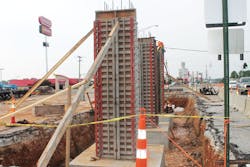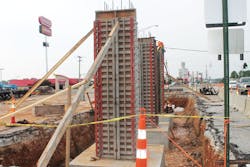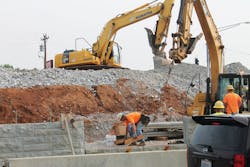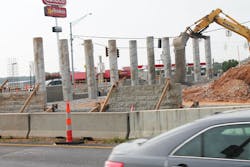Express checkout
Missouri is the “Show-Me” state. Indeed, that is exactly what transportation consultants needed to do when presenting that state’s department of transportation (MoDOT) with an innovative plan to convert a 3-mile stretch of U.S. 60, a major expressway linking Rogersville and Springfield, into something more than an access-controlled freeway—one that not only could improve mobility, but also spur economic development and create a gateway to the city.
Overpass piers alongside active traffic.
Work begins sculpting the base for new interchange buildup.
Handling a population that doubled over the last 10 years, the signalization controlling the artery’s traffic flow had created a frustrating stop-and-go traffic pattern jeopardizing safety. The design-build project proposed by RS&H (designer) and Radmacher Brothers (contractor) is designed to not only improve traffic flow while overcoming the risks associated with converting an expressway to a freeway, but also avoid creating physical divisions in the community, displacing the familiar locales of homes and businesses, and impacting the local environment.
Overpass stachions in place.
According to Sean Matlock, project designer for MoDOT, the primary goal of converting U.S. 60 from an expressway to a freeway was to safely accommodate future growth.
“The prominent design changes call for replacing the at-grade intersections with 21⁄2 interchanges, making it a more controlled and safer freeway,” he said.
Matlock said it was the first design-build project in MoDOT’s Southwest District and the first that required right-of-way acquisition. Because of that, he said, MoDOT really didn’t know if they could accept RSH/Radmacher’s new design until they knew just how much the right-of-way would cost. He said that MoDOT proposed to the design-build team that if they could come in under the planned right-of-way budget, the agency would consider adding additional scope to the project.
RS&H/Radmacher stepped up to plate and knocked it out of the park.
“Because of the savings provided by the design-build team, we were able to add as improvements a third bridge, including an overpass with two ramps,” said Matlock, “as well as space for development and connectivity of local traffic.”
MoDOT began to recognize the traffic problems on U.S. 60 in the late 1990s. The corridor was getting overwhelmed, and with three signals in a 60-mph speed limit it had become unsafe as well. The RFQ was advertised in December 2013. Four teams were short-listed in February 2014 and the project awarded that June. Design and construction began in August 2014 with the projected completion date set for December 2016.
Widely, quickly accepted
According to RS&H Project Manager Jim Shaw, public hearings for the project went exceedingly well. He said that the design-build team created a time-elapsed looped animated video of the project. To his surprise, the first public meeting yielded near unanimous support.
“It’s unusual to have so much acceptance at the first meeting,” said Shaw, adding that “the looped video impressed and educated the public so effectively that the community immediately understood the scope of the improvements.”
Matlock said there was some frustration at first among the community because the blackout period during which they met with the four short-listed design-build firms prevented them from releasing any information to the public for nine weeks.
“The first public meeting in August 2014 had 250 people—usually that is not good news,” said Matlock. “However, as soon as they saw the plans, the mood quickly became complimentary and most expressed that it couldn’t be built soon enough.”
According to Matlock, Missouri has had much success with its design-build projects. In 2011, the state completed the four-year Safe & Sound Bridge Improvement Program, which rebuilt 589 bridges.
Another component of the project was a community outreach program that allowed the team to partner with local schools and colleges in order to engage prospective engineering students. MoDOT administers a Diversity Outreach Program that cultivates interest in engineering careers among young women and minorities. In this case, the project team coordinated with the outreach program to educate its students on the details of the project. The team proposed a five-step program to demonstrate the value of the project to the community, as well as the value of civil engineering to society.
Backage, barbells, dogbones
Matlock said they welcomed the RS&H/Radmacher Brothers team’s expanded scope—although it called for acquiring 25 acres of right-of-way and may require more if an additional bridge is added—because he believed it could better ensure the area’s ability to sustain the forecasted growth.
“Once we discussed the plans and saw how it provided connectivity and optimum mobility through the corridor, as well as provided the community benefits of economic revitalization, we were on board,” said Matlock, adding the caveat, “and they were able to show how we could pay for it.”
Shaw said his team was motivated to come up with a progressive design that could revitalize the community as well.
“When you put in a freeway you divide a town, and we didn’t want to do that,” he said. “The right-of-way was an issue but they realized they had an opportunity to use the funds to do not only what was best for the freeway but also for the community by helping revitalize it. We were confident after putting together the RFP that we would be able to show MoDOT that they could get the additional right-of-way they needed and still come in under budget.”
RS&H brought in its transportation planner, Phil Hanegraaf, who demonstrated how similar designs were creating economic benefits in other parts of the country.
“This project included areas of the community they wanted to remain stable and new areas that were open for development,” said Hanegraaf. “Backage roads [often referred to as frontage roads] become critical to that equation in that they provide local access to where the community wants things to happen.”
He said that backage roads not only improve local circulation, but more importantly provide access opportunity for major new development.
“And the fact that the development community can be involved presents the opportunity to cover a substantial amount of the costs of the frontage road improvement,” he said. “This project demonstrates how important of a role planning plays in alternative project delivery.”
Hanegraaf’s vision was to create outer roads with enough space for a two-sided development that would accommodate commercial- and employment-based economic growth.
According to Matlock, the project features two unique interchanges that utilize roundabouts: a barbell roundabout and a unique, dogbone-shaped roundabout, both of which will efficiently accommodate future growth in the Springfield suburban area. The new freeway will provide three points of controlled access to the city of Rogersville from Greene and Webster counties, at the same time promoting an efficient circulation of vehicles and pedestrians throughout the city of Rogersville. In addition to the bridges, roundabouts and two-way backage roads, there are reconfigured, improved intersections and new turn lanes.
“Roundabouts are an effective design commonly used in Europe and are gaining popularity in the U.S.,” Matlock said. “They provide safety advantages by preventing T-bone crashes, and they are more sustainable because they avoid signalization, use less material and require less upkeep.”
Matlock said MoDOT wants to ensure that the community has the ability to sustain the type of growth it has seen in the past. To meet that goal, they are using this innovative intersection design for safety and to accommodate increases in traffic volume.
In addition, he said, the use of roundabouts also created an opportunity for new signage, more landscaping and aesthetic features, creating a gateway that welcomes travelers to the Rogersville community--—one where travelers have more options than just passing through. R&B



